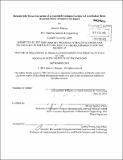| dc.contributor.advisor | Myron Spector. | en_US |
| dc.contributor.author | Macaya, Daniel J. (Daniel Joseph) | en_US |
| dc.contributor.other | Harvard--MIT Program in Health Sciences and Technology. | en_US |
| dc.date.accessioned | 2014-01-23T18:42:21Z | |
| dc.date.available | 2014-01-23T18:42:21Z | |
| dc.date.issued | 2013 | en_US |
| dc.identifier.uri | http://hdl.handle.net/1721.1/84410 | |
| dc.description | Thesis (Ph. D. in Medical Engineering and Medical Physics)--Harvard-MIT Program in Health Sciences and Technology, 2013. | en_US |
| dc.description | Cataloged from PDF version of thesis. | en_US |
| dc.description | Includes bibliographical references. | en_US |
| dc.description.abstract | Spinal cord injury (SCI) is a significant health issue resulting in life-long disability and associated secondary complications, affecting approximately 300,000 individuals in the United States. Primary barriers to functional recovery after SCI include the formation of a growth inhibitory astrocyte scar at the lesion border and a lack of a supportive stroma within the defect allowing for axon regeneration. Interestingly, in animals capable of spinal cord regeneration, astrocytes create a tissue bridge across the injury site to facilitate the regeneration of axons through the defect and thus enable functional recovery. The overall goal of this thesis was to develop an injectable collagen-genipin (Col-Gen) hydrogel to facilitate the intrinsic regenerative response after SCI by promoting the population of the defect with astrocytes through a provisional scaffold pennissive of astrocyte migration. The specific aims of the thesis involved: 1) development and materials characterization of an injectable collagen hydrogel for neural tissue regeneration, capable of undergoing covalent crosslinking in vivo; 2) evaluation of the permissiveness of Col-Gen gels with and without Fibroblast growth factor-2 (FGF-2), a known astrocyte chemoattractant, incorporated within lipid microtubules (LMTs) to infiltration by primary astrocytes using an in vitro cellular outgrowth assay; 3) evaluation of select formulations of the gel, based on the in vitro findings, in a standardized hemi-resection defect in the rat spinal cord. Functional, locomotor, and histopathological outcome measures, recorded up to 4 weeks post-SCI were correlated with each other and with micro MRI studies. In vivo, the implantation of Col-Gen gels containing FGF-2 LMTs resulted in the enhancement of astrocyte, blood vessel, and laminin infiltration of the defect; increased the amount of spinal cord tissue spared from secondary degeneration; and increased functional recovery, at four weeks post injury as compared to control or Col-Gen treatment groups. Micro MRI was found to be a suitable modality to nondestructively observe the features of the injury in situ. This work commends an injectable, covalently cross-linkable formulation of collagen gel incorporating FGF-2-releasing LMTs for further investigation for the treatment of SCI. | en_US |
| dc.description.statementofresponsibility | by Daniel J. Macaya. | en_US |
| dc.format.extent | 210 pages | en_US |
| dc.language.iso | eng | en_US |
| dc.publisher | Massachusetts Institute of Technology | en_US |
| dc.rights | M.I.T. theses are protected by
copyright. They may be viewed from this source for any purpose, but
reproduction or distribution in any format is prohibited without written
permission. See provided URL for inquiries about permission. | en_US |
| dc.rights.uri | http://dspace.mit.edu/handle/1721.1/7582 | en_US |
| dc.subject | Harvard--MIT Program in Health Sciences and Technology. | en_US |
| dc.title | Biomaterials-tissue interaction of an injectable collagen-genipin gel in a rodent hemi-resection model of spinal cord injury | en_US |
| dc.type | Thesis | en_US |
| dc.description.degree | Ph.D.in Medical Engineering and Medical Physics | en_US |
| dc.contributor.department | Harvard University--MIT Division of Health Sciences and Technology | |
| dc.identifier.oclc | 868020688 | en_US |
